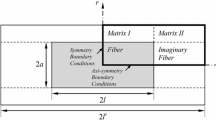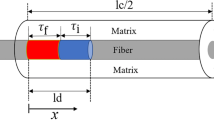Abstract
The strengthening mechanism of short fiber or whisker reinforced metal matrix composites has been studied by a continuum mechanics treatment utilizing finite element analysis (FEA). To assess the tensile and compressive constitutive responses, a constraint-unconstraint comparative study based on stress-strain hysteresis loop has been performed. For analysis procedures, the aligned axisymmetric single fiber model and the stress grouping technique have been implemented to evaluate the domain-based field quantities. Results indicate that the development of significant triaxial stresses within the matrix both for the tensile and compressive loading, due to the constraint imposed by reinforcements, provide an significant contribution to strengthening. It was also found that fiber stresses are not only sensitive to the fiber/fiber interaction effects but also substantially contribute to the composite strengthening both for the tensile and compressive loading.
Similar content being viewed by others
References
Agarwal, B. D., Lifsitz, J. M. and Broutman, L. J., 1974, “Elastic-Plastic Finite Element Analysis of Short Fiber Composites,”Fiber Science and Technology, Vol. 7, pp. 45–62.
Aresenault, R. J., 1983, “Interfaces in Metal Matrix Composites,”Scripta Metallurgica, Vol. 18, pp. 1131–1134.
Arsenault, R. J., 1984, “The Strengthening of Aluminum Alloy 6061 by Fiber and Platelet Silicon Carbide,”Materials Science and Engineering, Vol. 64, pp. 171–181.
Arsenault, R. J. and Fisher, R. M., 1983, “Microstructure of Fiber and Particulate SiC in 6061 Al Composites,”Scripta Metallurgica, Vol. 17, pp. 67–71.
Arsenault, R. J. and Pande, C. S., 1984, “Interfaces in Metal Matrix Composites,”Scripta Metallurgica, Vol. 18, pp. 1131–1134.
Arsenault, R. J. and Shi, N., 1986, “Dislocation Generation Due to Differences between the Coefficients of Thermal Expansion,”Materials Science and Engineering, Vol. 81, pp. 175–187.
Arsenault, R. J. and Taya, M., 1987, “Thermal Residual Stress in Metal Matrix Composite,”Acta Metallurgica, Vol. 35, pp. 650–659.
Cho, K. and Gurland, J., 1988,Metallurgical Transactions, Vol. 19A, p. 2027.
Christman, T., Needleman, A. and Suresh, S., 1989, “An Experimental and Numerical Study of Deformation in Metal-Ceramic Composites,”Acta Metallurgica, Vol. 37, No. 11, pp. 3029–3050.
Cook, R. D., Malkua, D. S. and Plesha, M. E., 1989. “Concepts and Applications of Finite Element Analysis,” John Wiley and Sons. Third Edition, pp. 163–295.
Derby, B. and Walker, J. R., 1988, “The Role of Enhanced Dislocation Density in Strengthening Metal Matrix Composites,”Scripta Metallurgica. Vol. 22, pp. 529–532.
Divecha, A. P., Fishman, S. G. and Karmarkar, S. D., 1981, “Silicon Carbide Reinforced Aluminum — A Formable Composite,”Journal of Metals, Vol. 33, No. 9, pp. 12–17.
Drucker, D. C., 1965,High Strength Materials. John Wiley & Sons. Inc., First Edition, Edited by Zackay, V. F., Chapter 21, Engineering and Continuum Aspects of High-Strength Materials, pp. 795–833.
Eshelby, J. D., 1957, “The Determination of the Elastic Field of an Ellipsoidal Inclusion, and Related Problems,”Proceedings of the Royal Society, London, Vol. A241, pp. 376–396.
Kelly, A. and MacMillan, N. H., 1986,Strong Solid, 3rd Edition, Clarendon Press, Oxford, p. 240.
Kim, H. G., 1992, “Micromechanics of Deformation in Short Fiber or Whisker Reinforced Metal Matrix Composites,” Ph. D Dissertation, Department of Mechanical Engineering, University of Massachusetts, Amherst, MA, USA.
Kim, H. G., 1994a, “Assessement of Plastic Constraint Effects Induced by Whisker Interactions in Whisker Reinforced Metal Matrix Composites,”Journal of the Korean Society for Composite Materials, Vol. 7, No. 3, pp. 1–10.
Kim, H. G., 1994b, “Stress Transfer in Shear Deformable Discontinuous Composites,”KSME Journal, Vol. 8, No. 4, pp. 475–484.
Kim, H. G., Chang, S. H., Chang, D. S. and Chung, S. K., 1994, “A Numerical Study Using Micromechanics Model for Metal Matrix Composites,”Proceedings of Materials Research Society of Korea, pp. 133–136.
Koss, D. A. and Copley, S. M., 1971, “Thermally Induced Residual Stresses in Eutectic Composites,”Metallurgical Transactions, Vol. 2, pp. 1557–1560.
Levy, A. and Papazian, J. M., 1991, “Elastoplastic Finite Element Analysis of Short Fiber Reinforced SiC/Al Composites: Effects of Thermal Treatments,”Acta Metallurgica, Vol. 39, No. 10, pp. 2255–2266.
Mori, T. and Tanaka, K., 1973, “Average Stress in Matrix and Average Elastic Energy of Materials with Misfitting Inclusions,”Acta Metallurgica, Vol. 21, pp. 571–574.
Murdeshwar, N., 1989, “Fracture Development in a 20 Volume Percent Silicon Carbide Whisker Reinforced AI 2124 Metal Matrix Composite,” M. S. Thesis, University of Massachusetts at Amherst, MA, USA.
Nair, S. V. and Kim, H. G., 1991, “Thermal Residual Stress Effects on Constitutive Response of a Short Fiber or Whisker Reinforced Metal Matrix Composite,”Scripta Metallurgica, Vol. 25, No. 10, pp. 2359–2364.
Nair, S. V., Tien, J. K. and Bates, R. C., 1985, “SiC Reinforced Aluminum Metal Matrix Composites,”International Metals Review, Vol. 30, No. 6, pp. 275–290.
Nardone, V. C., 1987, “Assessment of Models Used to Predict the Strength of Discontinuous Silicon Carbide Reinforced Aluminum Alloys,”Scripta Metallurgica, Vol. 21, pp. 1313–1318.
Nardone, V. C. and Prewo, K. M., 1986, “On the Strength of Discontinuous Silicon Carbide Reinforced Aluminum Composites,”Scripta Metallurgica, Vol. 20, pp. 43–48.
Piggot, M. R., 1980. “Load Bearing Fiber Composites,”Pergamon Press, pp. 83–99.
Takao, Y., Chou, T. and Taya, M., 1982, “Effective Longitudinal Young's Modulus of Misoriented Short Fiber Composites,”Journal of Applied Mechanics, Vol. 49, pp. 536–540.
Taya, M., and Arsenault, R. J., 1987, “A Comparison between a Shear Lag Type Model and an Eshelby Type Model in Predicting the Mechanical Properties of Short Fiber Composite,”Scripta Metallurgica, Vol. 21, pp. 349–354.
Taya, M. and Arsenault, R. J., 1989, “Metal Matrix Composites, Thermomechanical Behavior,” Pergamon Press, NY. Taya, M. and Mori, T., 1987, “Dislocations Punched-Out around a Short Fiber Metal Matrix Composite Subjected to Uniform Temperature Change,”Acta Metallurgica, Vol. 35, No. 1, pp. 155–162.
Vogelsang, M., Arsenault, R. J. and Fisher, R. M., 1986, “An In-Situ HVEM Study of Dislocation Generation at Al/SiC Interfaces in Metal Matrix Composites,”Metallurgical Transactions A, Vol. 17A, pp. 379–388.
Author information
Authors and Affiliations
Rights and permissions
About this article
Cite this article
Kim, H.G., Chang, I. Analysis of the strengthening mechanism based on stress-strain hysteresis loop in short fiber reinforced metal matrix composites. KSME Journal 9, 197–208 (1995). https://doi.org/10.1007/BF02953621
Received:
Issue Date:
DOI: https://doi.org/10.1007/BF02953621




